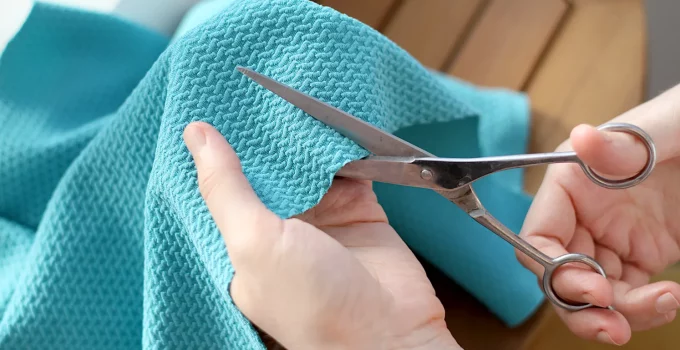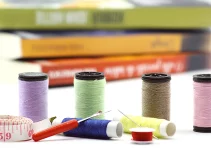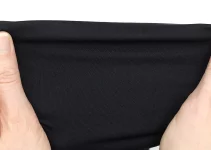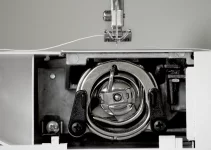When it comes to sewing, there are a number of tools that you’ll need along the way but, for now, let’s focus on talking about the main types of sewing scissors that we might need for our projects.
Even though there are several types of sewing scissors that amateurs and professionals will end up using, it also doesn’t mean that you’ll need all of them. It really depends on what type of projects you end up doing.
For example, if you’re just mending garments and other things then you’ll do fine with just one pair of scissors.
If you just plan on buying a single type of sewing scissors, I recommend getting a pair of good quality dressmaker shears. And maybe a good pair of embroidery scissors for more delicate work.
On the other hand, if you want to do your own patterns, I also recommend adding a pair of paper scissors to the list.
If you’re interested in checking out more tools that you might find useful, I wrote interesting articles about the best seam rippers, zipper alternatives, French curve rulers, and even about the best magnifying lamps for sewing.
Plus, check out my reviews for the best scissor sharpener if you plan on maintaining your favorite scissors as sharp as the day you bought them.
9 Types of Sewing Scissors

The main types of sewing scissors are:
- dressmaker’s shears
- embroidery scissors
- detail scissors
- thread snips
- paper scissors (designer scissors)
- pinking shears (zigzag scissors)
- curved scissors
- applique scissors
- embroidery snips
Check out my reviews for the best left handed scissors if you’re a lefty.
1. Dressmaker’s shears – One of the Most Important Sewing Scissors
These are the classic sewing scissors. If we’re talking about the main types of sewing scissors, dressmaker shears is the type that everyone should start with.
If you’re only buying one pair, buy this type and you’re good to go.
Dressmaker’s shears can also go by the name tailor scissors, fabric scissors or sewing scissors. Thus, all these 3 main types of scissors can be simply called dressmaker’s shears. They’re easily recognizable by their size and the shape of the handles.
The main characteristics of dressmaker’s shears are:
- the blades are very sharp, big, and thick- this is the type of sewing scissors that cuts through all kinds of fabrics and through multiple layers without stumbling
- tabletop cuts – the handle is offset from the blades so that the shears can cut fabric against a flat surface without any mishaps
- blade size: the blades can measure 6 inches or longer
- the handles come with one finger hole that is much smaller than the other – this is the characteristic that makes them so easily recognizable
- the large bow is usually on the side of the blade that points towards the floor
- they work for cutting through denim, leather, fabrics for upholstery, canvas, and any other type of heavy-weight fabric
- can be re-sharpened so you don’t have to buy a new pair once every few years – they’re forged to be used for a lifetime, just make sure to keep them sharp at all times
One last thing to pay attention to is the fact that dressmaker’s shears can come in both right and left-handed versions. If you’re left-handed make sure to get a pair for your dominant hand.
Moreover, you can find some very high-quality ones for a small price. If you have a limited budget, you can check out the Singer ProSeries Heavy Duty Bent Sewing Scissors.
If you have a more generous budget, I recommend checking out the Gingher 8-Inch Dressmaker’s Shears.
2. Embroidery scissors – Essential Sewing Scissor for Delicate Work
The main characteristic of embroidery scissors is that they’re very small.
Besides, being on the smaller side, they must also be very sharp. But that’s true for most types of sewing scissors.
If you find that your dressmaker shears are a bit too big for some projects, then you’ll benefit from adding a pair of embroidery scissors to your arsenal.
These are designed specifically for needlework. Since cross stitch and embroidery are all about delicate work, you also need a pair of delicate sewing scissors.
Characteristics
Most embroidery scissors will be 3-4 inches long but there are also mini versions that measure 2 inches long. It depends on how close you need to get to your work.
Usually, the blades are short and narrow. The tip is as sharp as the blades. That’s crucial.
You want to cut the thread cleanly from a single snip so that you don’t shred it. It will keep your work clean. That’s also why embroidery scissors work very well as thread snips, too.
When it comes to the design and size of the finger holes, there are two things they must meet: the finger holes need to be large enough to accommodate your fingers but small enough that you can have complete control over delicate work.
If you’re left-handed, make sure to buy embroidery scissors that have been designed for left-handed users.
If you want a good pair that doesn’t cost too much, I recommend the Singer 4.5” Forged Embroidery Stork Design Scissors.
3. Detail scissors – Similar to Embroidery Scissors
What makes detail scissors different from embroidery scissors? I’m pretty sure that not a lot of you could tell the difference.
Frankly, as far as I’m concerned, detail scissors are just embroidery scissors by another name.
If we were to describe them, we would say that they’re small scissors with pointed tip for intricate cutting. Does that sound identical or not?
Thus, if you already own a very sharp, capable pair of embroidery scissors, you certainly don’t need to add this type to your collection. Unless you really want to. In that case, you can check out the Singer ProSeries Detail Scissors with Nano Tip.
4. Thread snips
You don’t need to buy a pair that is specifically called thread snips if you already own a pair of very sharp embroidery scissors.
If you are the kind of person that prefers different types of sewing scissors for very particular tasks, then you’ll be interested to get both thread snips and embroidery scissors.
Thread snips will also be preferred by those whose fingers are too big for the finger holes on embroidery scissors. They’re also good for those who have arthritis.
Thread snips are used for: snipping threads at the beginning and end of each stitch, cut elastic and trims, trim and grade seam allowances, notch along curves to reduce bulk, etc.
Now you see why embroidery scissors can work as alternatives. The short, very sharp blades will also allow you to carefully cut close to seam lines.
For a cheap pair of thread snips, check out Singer ProSeries Thread Snips. A highly more expensive option is the Gingher Knife Edge Thread Nippers.
5. Paper scissors (designer scissors) – For cutting through sewing patterns
Just as the name clearly suggests, paper scissors are for those who want to cut through sewing patterns, interfacing, and they work for those who are passionate about various crafts.
You should never use your dressmaker’s shears to cut through paper because that will quickly cause them to become dull. Don’t do that.
If you want to cut through paper or interfacing, get a pair of paper scissors, like these Fiskars Softgrip Scissors Straight 8 Inch.
6. Pinking shears (zigzag scissors)
Just as the name in parentheses gives indication of, pinking shears are saw-toothed scissors that produce a zigzag pattern instead of a straight edge.
The major advantage of pinking shears is that this tool prevents fraying on raw hems. That is due to the fact that the fabric is cut in a zigzag pattern.
They can also be used to reduce fabric bulk on seam allowances.
Moreover, pinking shears can also be used for making some interesting, decorative edges to your projects.
Jistl Green Pinking Shears are an awesome choice is you need one of these.
7. Curved scissors – Curved tip scissors and double curved scissors
When it comes to curved scissors, there are actually two types to choose from: curved tip scissors and double curved scissors. I decided to cover them under the curved scissors umbrella because I don’t want to confuse or overwhelm you too much.
The curved tip type are scissors that have a slightly curved tip. They don’t look that much different from the classic embroidery shears.
These are used only for extremely fine precision work: getting under stitches or removing underlay stitches that have popped out. The same you can do with a very sharp pair of embroidery shears and a bit of attention to that delicate work so I don’t necessarily see the need to get a separate curved tip pair.
Double curved scissors are called that because both the handles and the tip are curved. The advantage they provide is that they confer better visibility when you’re trimming a hard-to-reach place.
Still, a good pair of embroidery scissors can also do the work that these curved models can do.
If you’re curious to see what a curved type can do, you can check out the Gingher 6 Inch Double-Curved Machine Embroidery Scissors.
8. Applique scissors (duckbill blade)
They’re easily identified by their duckbill blade. The purpose of the duckbill blade is to push down on one layer of the fabric while cutting the upper layer.
Thus, we don’t accidentally cut through the unwanted layer because it’s pushed down by the duckbill blade.
They have one main purpose: to trim applique fabric after being stitched down and before sewing over the raw edges of the applique fabric with a final satin stitch.
9. Embroidery snips
Embroidery snips don’t resemble any of the types of sewing scissors that we’ve talked about until now.
These look like some curved knitting needles or something like that, with the difference that two sharp blades are at one end. There are no loopholes to stick your fingers through.
You pick them up, squeeze and aim. That’s about how we use a pair of tweezers on our eyebrows.
Embroidery snips are designed in that particular manner in order to get close to the fabric and the base of the thread.
All in all, I hope you enjoyed this article talking about the main types of sewing scissors and that maybe it has helped you decide which of these tools would be best for your projects.




